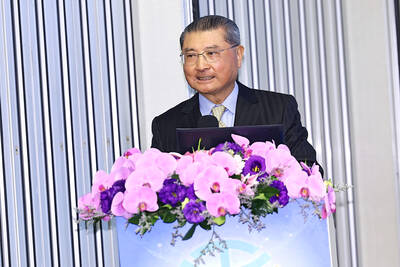The nation’s industrial production index fell 6.72 percent year-on-year to 89.6 last month, dropping for a 16th consecutive month on an annual basis, the Ministry of Economic Affairs said yesterday.
On a monthly basis, the index fell 1.65 percent as the global economy remained weak and a recovery in end-market demand was slow, the ministry said in a report.
The industrial production index gauges output in Taiwan’s four main industries: manufacturing, electricity and gas supply, water supply, and mining and quarrying.

Photo: CNA
The manufacturing production index, which contributed 95.41 percent to the industrial production index, dropped 7.01 percent annually to 88.81 last month — also the 16th consecutive month of annual declines, and also falling 1.65 percent from the previous month, the report said.
The production index for electricity and gas supply rose 2.1 percent from a year earlier, while the indices for water supply, and mining and quarrying were down by 2.39 percent and 15.88 percent respectively, the report said.
In the first nine months of this year, the industrial and manufacturing production indices fell 15.48 percent and 16.07 percent year-on-year respectively, the data showed.
The electronic components industry, which accounts for 49.57 percent of total manufacturing production, posted an annual decline of 9.38 percent in output last month, as a slump in semiconductor production offset the improvement in flat-panel production, the report said.
In the first nine months, the production of electronic components fell 21.92 percent from a year earlier, it said.
The machinery industry reported the largest output decline of 14.44 percent last month, as firms remained conservative regarding capital investment, which weighed on demand for semiconductor production equipment, linear guideways, electronic production equipment and special machinery items.
From January to last month, machinery goods production contracted 18.77 percent from the same period last year, the report said.
However, the output of the computer, electronics and optical products sector continued to rise last month, up 3.93 percent for a third consecutive month of annual increase, the report said.
The ministry attributed the increase to solid demand for servers, amid growing needs for cloud data services and artificial intelligence applications among companies.
However, slowing production of computer peripherals and components, industrial computers, laptops and other optical components decreased the sector’s output 2.94 percent year-on-year in the first nine months, the report said.
In traditional industries, producers of chemical materials and fertilizers last month posted a 0.43 percent drop in output, while suppliers of base metals reported that their output fell 0.97 percent.
Compared with the same period last year, the output of these two industries fell 14.28 percent and 12.01 percent respectively during the nine-month period, the report said.
The automobile and auto parts industry was a standout again among traditional industries, with output rising 0.53 percent year-on-year last month and increasing 1.55 percent in the first nine months, mainly due to strong sales of several new vehicle models and rising orders for auto parts, it said.

When an apartment comes up for rent in Germany’s big cities, hundreds of prospective tenants often queue down the street to view it, but the acute shortage of affordable housing is getting scant attention ahead of today’s snap general election. “Housing is one of the main problems for people, but nobody talks about it, nobody takes it seriously,” said Andreas Ibel, president of Build Europe, an association representing housing developers. Migration and the sluggish economy top the list of voters’ concerns, but analysts say housing policy fails to break through as returns on investment take time to register, making the

‘SILVER LINING’: Although the news caused TSMC to fall on the local market, an analyst said that as tariffs are not set to go into effect until April, there is still time for negotiations US President Donald Trump on Tuesday said that he would likely impose tariffs on semiconductor, automobile and pharmaceutical imports of about 25 percent, with an announcement coming as soon as April 2 in a move that would represent a dramatic widening of the US leader’s trade war. “I probably will tell you that on April 2, but it’ll be in the neighborhood of 25 percent,” Trump told reporters at his Mar-a-Lago club when asked about his plan for auto tariffs. Asked about similar levies on pharmaceutical drugs and semiconductors, the president said that “it’ll be 25 percent and higher, and it’ll

CHIP BOOM: Revenue for the semiconductor industry is set to reach US$1 trillion by 2032, opening up opportunities for the chip pacakging and testing company, it said ASE Technology Holding Co (日月光投控), the world’s largest provider of outsourced semiconductor assembly and test (OSAT) services, yesterday launched a new advanced manufacturing facility in Penang, Malaysia, aiming to meet growing demand for emerging technologies such as generative artificial intelligence (AI) applications. The US$300 million facility is a critical step in expanding ASE’s global footprint, offering an alternative for customers from the US, Europe, Japan, South Korea and China to assemble and test chips outside of Taiwan amid efforts to diversify supply chains. The plant, the company’s fifth in Malaysia, is part of a strategic expansion plan that would more than triple

Taiwanese artificial intelligence (AI) server makers are expected to make major investments in Texas in May after US President Donald Trump’s first 100 days in office and amid his rising tariff threats, Taiwan Electrical and Electronic Manufacturers’ Association (TEEMA, 台灣電子電機公會) chairman Richard Lee (李詩欽) said yesterday. The association led a delegation of seven AI server manufacturers to Washington, as well as the US states of California, Texas and New Mexico, to discuss land and tax issues, as Taiwanese firms speed up their production plans in the US with many of them seeing Texas as their top option for investment, Lee said. The